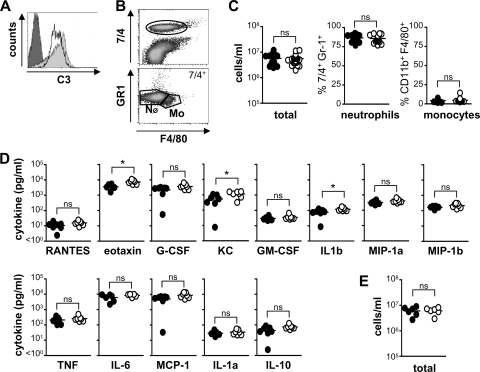FIG. 3.
C3 deficiency does not affect early inflammatory responses to C. albicans. C3−/− and wild-type mice were infected i.p. with 1 × 106 CFU of C. albicans, and inflammatory responses were measured at 4 h. (A) Incubation of isolated peritoneal fluid (gray histogram) or serum (unfilled histogram) with Candida albicans leads to C3 deposition on the fungal surface. The dark-gray portion of the histogram indicates unstained particles (secondary-only control). (B) Representative flow cytometric profiles showing the gates used (25) to identify recruited neutrophil (NØ) and monocyte/macrophage (Mo) populations. C3 deficiency does not affect cellular recruitment (wild type, 5.71 × 106 ± 4.31 × 105 total cells/ml) (C) or reduce inflammatory cytokine production (D) following i.p. administration of C. albicans. The values for the wild type are as follows: RANTES, 10.5 ± 2.0 pg/ml; G-CSF, 2,218 ± 434 pg/ml; granulocyte-macrophage CSF (GM-CSF), 29.7 ± 3.7 pg/ml; macrophage inhibitory protein 1α (MIP-1a), 313 ± 36 pg/ml; tumor necrosis factor (TNF), 211 ± 37 pg/ml; IL-6, 6,161 ± 1,169 pg/ml; monocyte chemoattractant protein 1 (MCP-1), 5,062 ± 941 pg/ml; IL-1α (IL-1a), 28.8 ± 3.6 pg/ml; IL-10, 43.7 ± 10.0 pg/ml; and macrophage inhibitory protein 1β (MIP-1b), 167 ± 12 pg/ml. Values for the wild type versus C3−/− are as follows: eotaxin, 3,557 ± 538 versus 7,368 ± 811 pg/ml; KC, 539 ± 142 versus 1,124 ± 180 pg/ml; and IL-1β (IL-1b), 77 ± 14 versus 120 ± 11 pg/ml. (E) C3 deficiency also has no effect on inflammation following i.p. infections with higher doses (1 × 107) CFU of C. albicans (wild type, 6.02 × 106 ± 9.32 × 105 total cells/ml). *, P < 0.05 (n > 6 animals per group per experiment). The data shown in panel C are pooled from three independent experiments. Bars indicate mean values of the data.

